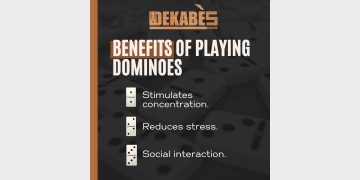Puerto Rican Dominoes Rules
Published on: 06 Sep 2022

On the Caribbean islands, domino games are played
with enthusiasm. Usually, the game is played loudly, with the violently
crashing of dominoes upon a table as people engage in a competitive game.
However, almost every Caribbean Island has a set
of unique rules they apply when playing this exciting and engaging game.
In Puerto Rico, the dominoes game is regarded as
the national board game. Every village on the island has tables in the main
square, where most people grew up watching elders play this game by strict
rules.
Let's take a closer look at the Puerto Rican
dominoes rules.
The Basic Rules of Puerto Rican Dominoes
Before we proceed to how the game is played,
there are basic things you must keep in mind concerning the Puerto Rican
dominoes.
●
The game is played
with a double-six domino set containing 28 tiles.
●
A maximum of
four players play it.
●
You need a
small square table to bang your tiles.
●
Get a pen
and paper to record scores.
●
Don't forget
your favorite beverage to cool the moment.
●
Each player
draws 7 bones once the bones are all shuffled face down.
●
The
remaining bones are piled up on the side in games for two or three players to
form the boneyard.
● Each participant keeps their dominoes a personal
secret.
They can do this by placing the bones on special
domino racks that keep them on their short end by holding 3 in one hand and 4
in the other or by positioning the bones on their long ends on the table so
that only he can see them.
Playing It the Puerto Rico Way
Puerto Rican dominoes is a game that has been
around for centuries and is played with rectangular tiles. The game is like
other domino games, but players must follow a few unique rules.
Now, if you're interested in learning how to play
Puerto Rican dominoes, let us get to it.
Every game begins with a player placing the tiles
face down on a level surface and thoroughly mixing them with his hands.
The player who does the shuffling shall be the
last to draw his hand for the game. However, the player's hands may not remain
on the same tiles during the shuffling.
The dominoes can be shuffled before each game by
a different player or by the players taking turns.
However, only the player making the game's
opening play or the game's winner from the previous round can do the shuffling.
Each of these tiles has two numbers, ranging from
0 to 6. The game's object is to be the first player to eliminate all of your
tiles.
Whoever has the domino with the six dots on each
end is the first to go, and matching the dots is done in turns by the
participants. Then after that domino is played, someone matches the lead
domino's end with one of his dominoes with a six.
Furthermore, although the game is played
counterclockwise, the players sit around the table in a clockwise manner.
So, partners are players who sit on opposite
sides of the table. As a result, A and C, as well as B and D, are partners if
players A, B, C, and D sit in a clockwise direction.
Teams can be arranged by players using any
technique. However, the approach frequently used is that:
●
Each player
receives a tile.
●
The two
players with the highest tiles (highest pips) form partnerships.
● The other players make up the opposing team.
Also, one of the players takes charge of keeping
the scores. This player must draw a vertical line dividing a sheet of paper
into two columns. Both sides are scoreless at the outset.
The End of a Game
The game continues until one player has played
his last dominoes, or there is no other one to match. The individual who has
the fewest points (or pips) in the latter scenario wins.
So, the game ends when the players empty their
hands of as many dominoes as possible and do so first. Other players must then
add up the unclaimed points or pips to keep track of their score. After that,
the winner is determined by the lowest point.
For a team game, a team loses a game if they
score 100 points or more. Therefore, a 50-point or 200-point game is feasible
by modifying the game's total score of 100 points to make it last longer or
shorter.
Terminologies Used in the Puerto Rican Dominoes
Below are some basic and regularly used terms
when playing dominoes the Puerto Rico way:
●
Chiva
is a way of saying "shutout." A team is said to be on Chiva, when it
has consistently lost more than a few games.The team reportedly "romper la
Chiva!" (Broke the Chiva) following their first victory and was branded as
"winless." For a side to win the Chiva game, they must win 4 straight
games. A team that shuts out another (100-0, 200-0, or 500-0) in a game for
points (100, 200, or 500) is said to have handed the other team a
"Chiva"! In games for points, this is a challenging thing to
accomplish. A good example of the Chiva game is the Dekabès Domino.
●
Capicú
refers to when the winning bone may use any open end of the arrangement.
However, it does not apply when a double is a winning bone.
●
Ahorcado is a double that can no longer come into play since the
other six dominoes in that suit have all been used. It is also referred to as a
"hanged double."
●
Pase
refers to when a player or team cannot play. It is usual for a player to hit
one of his bones on the table to indicate a pass. He can also use the word
"Paso" to indicate the pass. Sometimes, teams earn extra points for
forcing their opponents to pass.
●
Trancado is the last played bone before a blocked game.
●
Chucha
means a double zero, also called double blank.
●
Chuchazo refers to when the double blank (Chucha) is the winning
bone.
●
Trampa
is an illegal move or cheat.
● Mano is a term for the player with the least domino
and a single game.
Bottom Line
Give these Puerto Rican styles a try if you're
seeking a new game or a new variant to play at your next domino game with pals.
All around the Caribbean and even in some parts
of Mexico, these styles are still played today as they originated in Puerto
Rico. So, gather your buddies together, clean the domino set, and enjoy a fun
Puerto Rican dominoes get-together.
To be up to date with everything concerning your
favorite Caribbean game, don't forget to follow Dekabès Domino on Facebook,
Instagram, Twitter, LinkedIn, Youtube, Twitch and TikTok.





